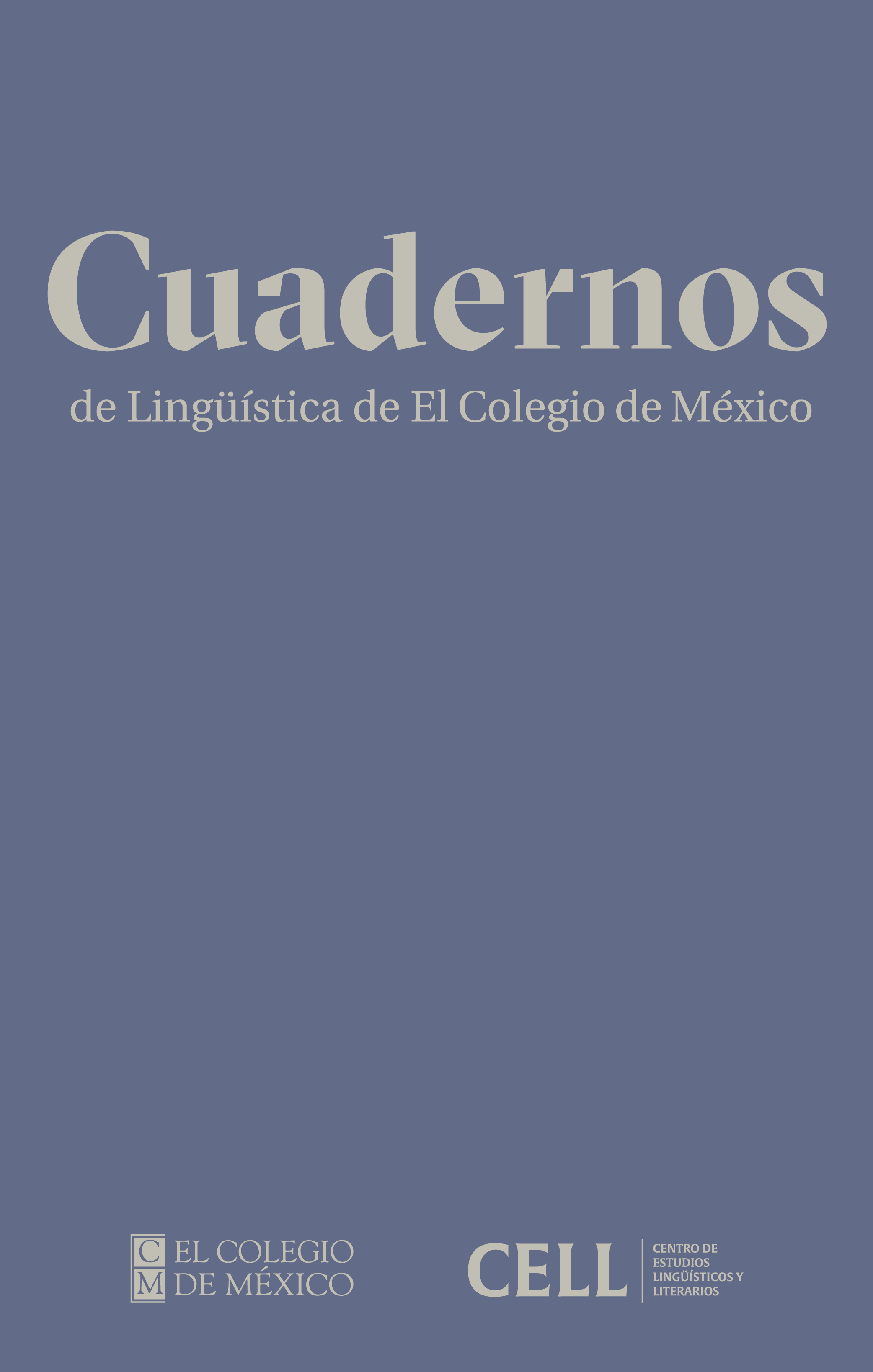Lexical-syntactic description of the past participle form in relation to the prepositional structure headed by “bajo” (under) in Spanish
DOI:
https://doi.org/10.24201/clecm.v12.331Keywords:
semantic alternation, prepositional phrase, past participle, perfectivity, focalizationAbstract
This study explores the semantic and aspectual factors that allow for the alternation between the prepositional phrase with the structure ‘bajo + NP’ and the morphological construction of the past participle, as seen in the examples: The family was under the threat of the most feared gang of those times / The family was threatened by the most feared gang of those times. Using semantic-aspectual analysis tools (Rappaport-Hovav & Levin 1998; Mendikoetxea 2000), the structures and/or mechanisms were evaluated to identify the factors that motivated the alternation between the prepositional phrase and the morphological construction of the past participle. The source of examples was mixed: a) Cases from the scientific literature and original examples. It was found that the factors involved in the alternation are related to the Aktionsart of the predicates in which they are embedded (De Miguel 1999; Escandell 2004, 2007; Morimoto 2017) and are linked to the event structure [COME TO BE [x<STATE>]], which focuses on the culmination subevent, explaining its alternation with morphological past participle constructions, also associated with a perfective character. Similarly, the viewpoint aspect (Smith 1997) will also affect the semantic alternation. The scientific novelty and relevance of this research lie in its focus on studying the prepositional group in relation to other categories (Masullo 2008; Gallego 2010; Brucart & Gallego 2016), thereby contributing to a grammatical study that establishes relationships not only at the intracategorial level but also at the intercategorial level.
Downloads
References
Baker, Mark C. 2003. Lexical categories; verbs, nouns and adjectives. Cambridge: Cambridge University Press. https://doi.org/10.1017/CBO9780511615047
DOI: https://doi.org/10.1017/CBO9780511615047Bosque, Ignacio. 2015. Las categorías gramaticales; relaciones y diferencias. Madrid: Síntesis, S. A.
Brousseau, Anne-Marie & Ritter, Elizabeth. 1991. A non-unified analysis of agentive verbs. En Bates, Dawn (ed.), The Proceedings of the Tenth West Coast Conference on Formal Linguistics, 53-64. Stanford, CA: CSLI Publications.
Brucart, José María & Gallego, Ángel J. 2016. Aspectos formales e interpretativos de la subordinación adverbial. En Pavón Lucero, María Victoria. (ed.), Las relaciones interoracionales en español; categorías sintácticas y subordinación adverbial, 161-200. Berlín: De Gruyter. https://doi.org/10.1515/9783110429213-006
DOI: https://doi.org/10.1515/9783110429213-006Burzio, Luigi. 1981. Intransitive verbs and Italian auxiliaries. Massachusetts: Massachusetts Institute of Technology. (Tesis doctoral.)
Burzio, Luigi. 1986. Italian syntax; a government-binding approach. Dordrecht: Springer. https://doi.org/10.1007/978-94-009-4522-7
DOI: https://doi.org/10.1007/978-94-009-4522-7Chierchia, Gennaro. 1989. A semantics for unaccusatives and its syntactic consequences. Manuscrito. Nueva York: Universidad de Cornell.
Chomsky, Noam. 1981. Lectures on government and binding. Dordrecht: Foris.
Codita, Viorica. 2013. Locuciones prepositivas en el español medieval; siglos XIII-XV. Universitat de València. (Tesis doctoral.)
De Bruyne, Jacques. 1999. Las preposiciones. En Bosque, Ignacio & Demonte, Violeta. (coords.), Gramática descriptiva de la lengua española, 657-703. Madrid: Editorial Espasa Calpe, S. A.
Doron, Edit. 2014. The interaction of adjectival passive and voice. En Alexiadou, Artemis, Borer, Hagit and Schäfer, Florian (eds.), The syntax of roots and the roots of syntax, 164-191. Oxford University Press. DOI: https://doi.org/10.1093/acprof:oso/9780199665266.003.0008
DOI: https://doi.org/10.1093/acprof:oso/9780199665266.003.0008Escandell Vidal, María Victoria. 2004. Fundamentos de semántica composicional. Barcelona: Editorial Ariel, S.A.
Escandell, María Victoria. 2007. Apuntes de semántica léxica. Madrid: Editorial Cuadernos de la UNED.
Gallego, Ángel. 2010. On the prepositional nature of non-finite verbs. Catalan Journal of Linguistics 9(1). 79-102. https://doi.org/10.5565/rev/catjl.95
DOI: https://doi.org/10.5565/rev/catjl.95Gatto, Maristella. 2014. Web as corpus; theory and practice. Bloomsbury Academic.
Kratzer, Angelika. 2005. Building statives. En Guéron, Jacqueline & Lecarme, Jacqueline (eds.), The syntax of time, 385-399. MIT Press. [Original de 1996].
Maldonado, Ricardo. 2005. El gerundio español como progresivo estático. Análisis cognoscitivo. Revista Española de Lingüística 35(2). 433-460.
Masullo, Pascual. 2008. The syntax-lexical interface; prepositionalizing motion verbs in Spanish. University of Pittsburgh.
Mateu, Jaume. 2002. Argument structure; relational construal at the syn-tax-semantic interface. Universitat Autònoma de Barcelona. (Tesis doctoral.)
Medina, Raimundo & Matera, Masiel. 2011. El clítico se en español y las clases de evento. Argos 28(55). 137-168.
Mendikoetxea, Amaya. 2000. Relaciones de interficie; los verbos de cambio de estado. Cuadernos de Lingüística 7. 125-144.
Mendikoetxea, Amaya. 2009. Modelos formales. En De Miguel Aparicio, Elena. (ed.), Panorama de la lexicología, 301-336. Barcelona: Editorial Ariel, S.A.
Moliner, María. 2012. Uso de las preposiciones. Madrid: Editorial Gredos, S. A. U.
Morera Pérez, Marcial. 1990. La preposición española “contra”; su evolución semántica. Thesaurus: Boletín del Instituto Caro y Cuervo 45(3). 650-689.
Morimoto, Yuko. 2017. El aspecto léxico; delimitación. Madrid: Editorial Arco/Libros, S.L.
Pavón Lucero, María Victoria. 1999. Clases de partículas; preposición, conjunción y adverbio. En Bosque, Ignacio & Demonte, Violeta. (coords.), Gramática descriptiva de la lengua española, 565-656. Madrid: Editorial Espasa Calpe, S. A.
Pérez Botero, Luis. 1997. Anterioridad y perfectividad en el sistema verbal del español. Sintagma 9. 5-15.
Rappaport-Hovav, Malka & Levin, Beth. 1998. Building verb meanings. En Butt, Miriam & Geuder, Wilhelm (eds.) The projection of arguments; lexical and compositional factors, 97-134, Stanford: CSLI Publications.
Real Academia Española (RAE) & Asociación de Academias de la Lengua Española (ASALE). 2009. La preposición y el grupo preposicional. En RAE & ASALE, Manual de la nueva gramática de la lengua española, 2223-2284. Madrid: Espasa Libros, S. L. U.
Schütze, Carson T. 2016. The empirical base of linguistics; grammaticality judgments and linguistic methodology. (Classics in Linguistics 2). Ber-lín: Language Science Press. https://doi.org/10.17169/langsci.b89.100
Smith, Carlota S. 1997. The parameter of aspect. Springer Dordrecht. ht-tps://doi.org/10.1007/978-94-011-5606-6
Vendler, Zeno. 1957. Verbs and times. The Philosophical Review 66(2). 143-160. https://doi.org/10.2307/2182371
DOI: https://doi.org/10.2307/2182371Downloads
Published
How to Cite
-
Abstract28
-
PDF (Español)11
Issue
Section
License
Copyright (c) 2025 Yesenia Ramírez Fuentes

This work is licensed under a Creative Commons Attribution-NonCommercial 4.0 International License.
Authors retain copyright of their work and are free to disseminate it, make copies for any use, and/or deposit in any repository or archive of their choice, but they grant Cuadernos de Lingüística de El Colegio de México the right to publish the work for the first time. Authors agree to acknowledge Cuadernos de Lingüística de El Colegio de México as the site of original publication of their article / note / review through proper citation.
Articles appearing in Cuadernos de Lingüística de El Colegio de México are made available to readers under a Attribution-NonCommercial-NoDerivatives 4.0 International.









